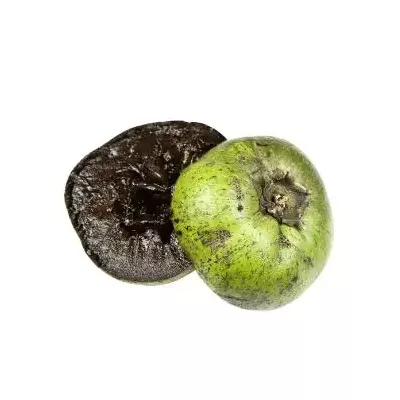



Black Sapote is also known as the "chocolate pudding fruit" because its flesh has a texture and flavour that are similar to chocolate pudding.

Pay using UPI, Card or Netbanking

Shipping within 3 working days
Black sapote is an evergreen fruit plant that grows well in tropical and subtropical climates without much care. It is called black sapote because of the colour of the fruit pulp inside.
Chikku (sapote) is not related to Black sapote. They belong to different botanical families.
Black sapote requires plenty of water and needs full sun for proper fruiting. It can tolerate mildly acidic to mildly alkaline soils.
Occasional organic fertilisers would be sufficient. The plant grows without much care otherwise.
Black sapote does not usually become large trees. Expect a height of 6 to 8 metres on average. Rarely, it grows to a height of 15 metres or more. It grows slowly in the initial years, then speeds up.
Trees with only female flowers, or with both female and male flowers, bear fruit. In the former case, the presence of a male is needed.
Using grafted plants as the planting material can solve this problem. Grafted plants usually fruit in 2–3 years. Seedlings take 4-6 years to fruit.
It is possible to grow Black sapote in a container. Choose a container of 120 litres or more filled with a good container potting mix.
Black sapote fruit is mildly sweet. It is a rich source of vitamin C, calcium, and phosphorus. Unripened black sapote can be boiled and used as a vegetable.
Mature fruit will weigh about 500 g. The inside of the fruit looks like dark chocolate.
The fruit, until it reaches maturity, is green in colour.
Black sapote is only to be consumed when fully ripe. This can easily be distinguished from the colour of the peel and the shape of the fruit.
When mature, the sepal will lift off from the fruit. At this point, it is ready for harvest. The fruit colour is still a fresh green.
The sepal will start becoming dry, and the outer colour of the fruit starts getting duller. When pressed with your fingers, the fruit feels soft.
However, it needs to be so soft that when kept on a table, the bottom should become flat. Wrinkles appear, and the fruit appears to be losing shape.
At this time, the fruit would have turned an olive green colour. The fruit at this stage appears overripe, but that is the right time to consume a black sapote. This may take 3–10 days from the time of harvest.
Harvesting the fruit before it ripens on the tree is recommended because the fruit may be eaten by birds. Also, the ripe fruits are soft and will fall and break all over.
Mature trees are very productive, bearing plenty of fruits.
Diabetes patients can consume this fruit as it has less sugar.
While consuming the fresh fruit is good, it is often mixed with other fruits or milk to make smoothies. Its taste blends very well with milk and with fruits like lime, orange, and pineapple.
The pulp can also be used for baking and making ice cream and pudding.
Lift off the top of the fruit. This should come off easily for a fully ripe fruit. Cut it in half with a knife. Scoop out the pulp using a spoon or a knife.
Data sheet